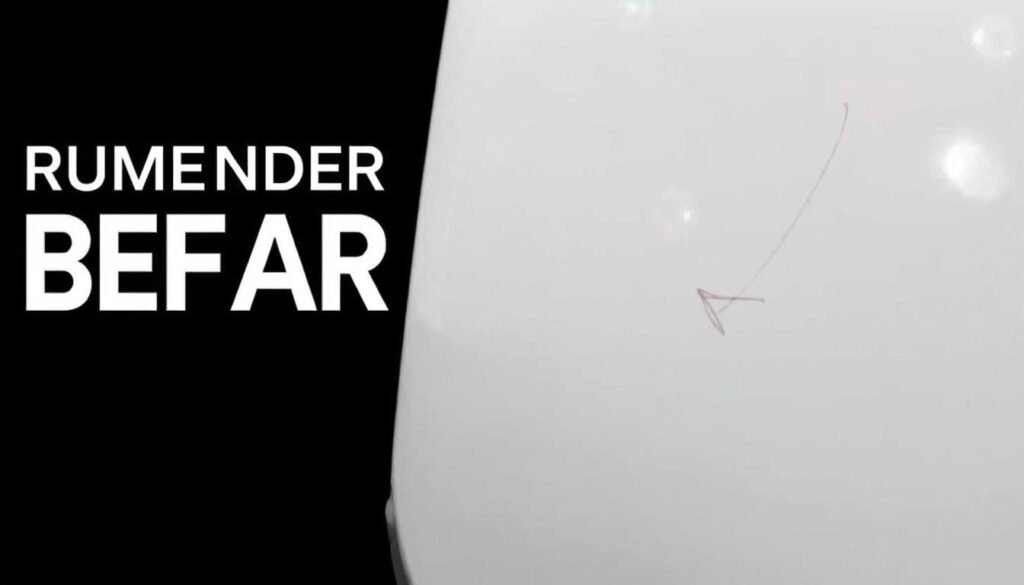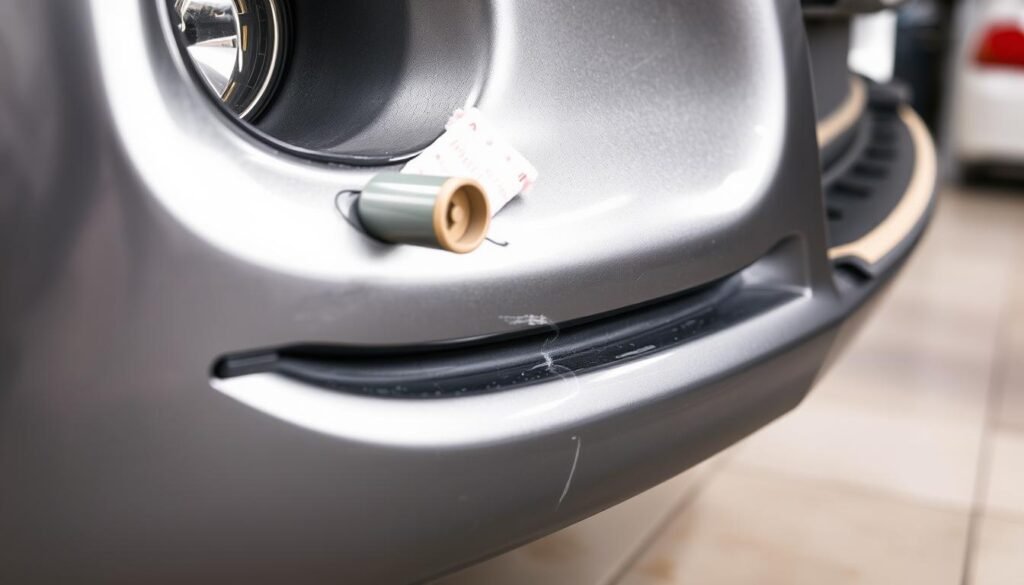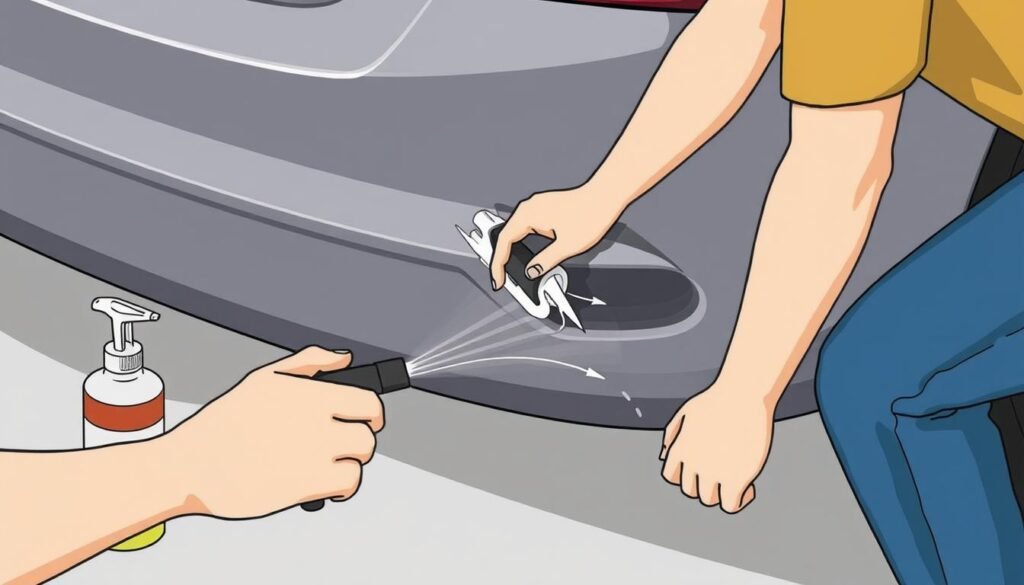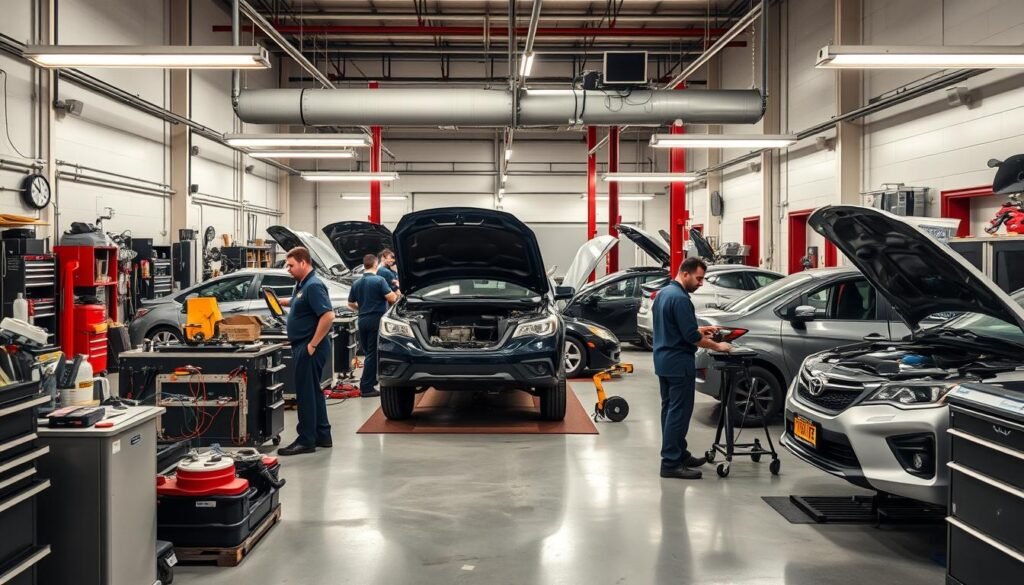Are you tired of looking at that unsightly bumper scratch on your car? Not only can it be aesthetically displeasing, but it can also lead to further damage if left unrepaired.
As a car owner, you’re likely aware that bumper scratches are an almost inevitable part of vehicle ownership. However, understanding the cost of repair can be daunting.
The truth is, repair costs can vary widely depending on the severity of the damage, the type of car you own, and the repair method used.
This comprehensive guide will walk you through the complex world of bumper repair costs, covering average prices, factors affecting the price, different repair techniques, and insurance considerations.
Key Takeaways
- Understand the factors that affect bumper scratch repair costs.
- Learn about the different repair techniques and their associated costs.
- Discover car insurance options that cover bumper damage.
- Find out cost effective ways to repair your car‘s bumper.
- Get an overview of average repair prices for bumper scratches.
Understanding Bumper Scratches and Their Impact
The integrity of your vehicle’s bumper is vital, and scratches can compromise both its form and function. Your vehicle’s bumper is designed to absorb impact, protecting more critical components from damage. When a bumper is scratched, it not only affects the appearance of your vehicle but can also potentially lead to more severe issues if not addressed properly.
Common Causes of Bumper Scratches
Bumper scratches can result from various incidents, including minor collisions, parking mishaps, or even environmental factors such as branches or debris on the road. These scratches can be superficial, affecting only the clear coat, or they can be more severe, penetrating to the paint layer or even the base material of the bumper.
Why Prompt Repair Matters
Prompt repair of bumper scratches is essential to prevent further damage. If left unrepaired, scratches can lead to rust or further deterioration, especially if the scratch has exposed the metal underneath. Moreover, a damaged bumper can also affect the overall aesthetic appeal of your vehicle, potentially reducing its resale value.
Assessing the Severity of Bumper Damage
To determine the best course of action, it’s crucial to assess the severity of the bumper damage. This involves examining the bumper for dents, scratches, cracks, or any other visible damage. The extent of the damage will dictate whether a simple touch-up is sufficient or if more extensive repairs are needed.
| Type of Damage | Description | Typical Repair Approach |
|---|---|---|
| Surface Scratches | Affecting only the clear coat | Paint touch-up or clear coat repair |
| Moderate Scratches | Penetrating to the paint layer | Paint repair and possible primer application |
| Deep Scratches | Reaching the primer or base material | Extensive repair including possible replacement of bumper parts |
Average Cost to Fix a Bumper Scratch
The cost to fix a bumper scratch can vary significantly based on several factors, including the severity of the damage and the type of vehicle.

Cost Range for Minor Surface Scratches
Minor surface scratches typically require simple touch-ups or paintless dent repair techniques. The cost for such repairs can range from $50 to $300, depending on the location and the technician’s expertise. For economy cars, the cost tends to be on the lower end of this spectrum.
Cost Range for Moderate Scratches
Moderate scratches that affect the paint and possibly the bumper material itself can cost between $300 and $1,000 to repair. The process may involve repainting the bumper and potentially replacing some parts. Luxury vehicles or those with specialized bumper designs can incur costs at the higher end of this range due to the need for specific materials and techniques.
Cost Range for Deep Scratches and Paint Damage
Deep scratches that penetrate through the paint and damage the bumper’s structure can be costly to repair, with prices ranging from $1,000 to $3,000 or more. In some cases, if the damage is extensive, it might be more economical to replace the bumper entirely. The cost is also influenced by whether the vehicle is a luxury model or has aftermarket modifications.
Cost Comparison by Vehicle Type
The type of vehicle significantly affects the repair cost. For instance, economy cars generally have lower repair costs compared to luxury vehicles. SUVs and trucks, due to their larger size, may also have higher costs. Here’s a comparative overview:
- Economy cars: $50-$500
- Mid-size sedans: $100-$800
- Luxury vehicles: $300-$1,500 or more
- SUVs and trucks: $200-$1,000 or more
The cost to fix a bumper scratch is not only dependent on the damage severity but also on the vehicle’s make, model, and type. Understanding these factors can help you estimate the potential cost and make informed decisions about your vehicle’s repair.
Factors That Affect Bumper Scratch Repair Costs
Bumper scratch repair costs are not one-size-fits-all; they are determined by a variety of factors unique to each vehicle and situation. Understanding these factors can help you anticipate and potentially mitigate the costs associated with repairing your vehicle’s bumper.
Extent and Depth of Damage
The severity of the scratch plays a significant role in determining repair costs. Minor surface scratches that haven’t penetrated the paint layer are generally less expensive to fix than deeper scratches that expose the underlying material or cause structural damage.
Bumper Material and Construction
The type of material used in your vehicle’s bumper significantly affects repair costs. Modern bumpers are made from a variety of materials, including plastic, fiberglass, and aluminum. Plastic bumpers, common in many vehicles, can be less expensive to repair than metal ones, depending on the extent of the damage.
Vehicle Make and Model
The make and model of your vehicle influence repair costs due to differences in bumper design, material, and the cost of replacement parts. Luxury or high-performance vehicles often have more expensive parts and may require specialized labor, increasing repair costs.
Paint Matching Requirements
If the scratch has damaged the paint, achieving a seamless repair requires matching the original paint color and finish. This process can be challenging and costly, especially for vehicles with unique or metallic paint jobs.
Geographic Location
Your location also plays a crucial role in determining bumper scratch repair costs. Urban areas typically have higher labor rates and shop overheads compared to rural areas, making repair services more expensive. Additionally, regions with strict environmental regulations may incur additional costs due to compliance requirements.
To illustrate how these factors can influence repair costs, consider the following table:
| Factor | Low-Cost Scenario | High-Cost Scenario |
|---|---|---|
| Extent and Depth of Damage | Minor surface scratch | Deep scratch with paint damage |
| Bumper Material | Plastic | Aluminum or Fiberglass |
| Vehicle Make and Model | Economy vehicle | Luxury or high-performance vehicle |
| Paint Matching | Standard solid color | Unique or metallic paint |
| Geographic Location | Rural area | Major metropolitan area |

By understanding these factors, you can better estimate the potential cost of bumper scratch repairs for your vehicle and make informed decisions about where and how to have the work done.
Repair Techniques for Bumper Scratches
When it comes to fixing bumper scratches, various techniques are employed depending on the severity and type of damage. The right method ensures a durable and visually appealing repair. Understanding these techniques can help you make informed decisions about your vehicle’s auto body maintenance.
Paintless Dent Repair (PDR)
Paintless Dent Repair (PDR) is a technique used for minor dents and dings where the paint is intact. It involves manipulating the metal from behind to restore its original shape. This method is cost-effective and preserves the original paint job.
Traditional Dent and Scratch Repair
For more significant damage, traditional dent and scratch repair methods are used. This involves filling the damaged area, sanding it down, and repainting to match the original color. It’s a more labor-intensive process but effective for deeper scratches and dents.
Paint Touch-Up and Refinishing
Paint touch-up and refinishing are crucial for restoring the bumper‘s appearance. This process involves carefully matching the original paint color and applying it to the repaired area. Advanced techniques ensure a seamless blend with the surrounding paint.
When Plastic Welding Is Necessary
Plastic welding becomes necessary for bumper repairs when there are cracks, splits, or broken mounting points, especially in plastic bumpers. The process involves using heat to melt compatible plastic rods into the damaged area, restoring structural integrity. Different techniques like hot air welding, ultrasonic welding, and plastic stapling are used based on the type of plastic and extent of damage.
| Repair Technique | Description | Application |
|---|---|---|
| Paintless Dent Repair (PDR) | Manipulating metal from behind to restore original shape | Minor dents with intact paint |
| Traditional Dent and Scratch Repair | Filling, sanding, and repainting damaged areas | Deeper scratches and dents |
| Paint Touch-Up and Refinishing | Matching and applying original paint color | Restoring appearance after repair |
| Plastic Welding | Using heat to melt plastic rods into damaged areas | Cracks, splits, or broken mounting points in plastic bumpers |

DIY vs. Professional Bumper Scratch Repair

If you’re dealing with a bumper scratch, you’re likely weighing the pros and cons of DIY repair versus professional repair services. The decision between these two approaches depends on several factors, including the extent of the damage, your budget, and your comfort level with DIY projects.
When DIY Repair Is Appropriate
DIY repair kits can be a cost-effective solution for minor bumper scratches. These kits usually include touch-up paint, scratch removers, and other tools necessary for a basic repair. If the scratch is superficial and doesn’t involve significant paint damage or deep gouges, a DIY kit might be sufficient.
Popular DIY Repair Kits and Their Effectiveness
Several DIY repair kits are available on the market, ranging from basic scratch removers to comprehensive repair packages. While these kits can be effective for minor scratches, their success largely depends on the user’s skill level and the extent of the damage. Some popular options include kits from well-known automotive suppliers.
Limitations of DIY Approaches
While DIY repair kits can be a quick fix, they have several limitations. They often lack the precision and quality of professional repairs, and the results may not last as long. Additionally, DIY repairs can be challenging if the scratch involves complex paint matching or significant damage.
Benefits of Professional Repair
Professional auto body shops offer several advantages over DIY repairs. They have access to manufacturer-specific repair procedures and materials, ensuring a proper restoration. Professional color matching systems can precisely match even complex paint finishes. Moreover, professional repairs include proper preparation, priming, and clear coat application, ensuring long-term durability.
By choosing professional repair, you also benefit from controlled environments that prevent dust contamination and ensure proper curing. Professional technicians can identify and address underlying damage that might not be visible to the untrained eye. Furthermore, professional repairs typically come with warranties, protecting your investment and maintaining your vehicle’s value.
Repair vs. Replacement: Making the Right Decision
Facing a scratched bumper, you must weigh the pros and cons of repair versus replacement to make an informed decision. The choice between these two options depends on several factors, including the extent of the damage, the cost implications, and the overall value of your vehicle.
When Repair Is the Better Option
Repairing your bumper is often the more cost-effective solution when the damage is minor to moderate. For surface scratches or small dents, techniques like paintless dent repair (PDR) or simple touch-ups can restore your bumper’s appearance without the need for extensive work. Repair is typically the better choice when the damage doesn’t compromise the structural integrity of the bumper.
When Replacement Makes More Sense
In cases where the damage is severe, such as deep cracks, significant paint damage, or when the bumper is broken, replacement might be the more sensible option. Replacing the bumper ensures that your vehicle maintains its safety features and aesthetic appeal. Additionally, if the cost of repair approaches or exceeds the cost of a new bumper, replacement is likely the better value.
Cost Comparison Between Repair and Replacement
Understanding the costs involved in both repair and replacement is crucial. Here’s a breakdown of the typical costs:
| Service | Cost Range |
|---|---|
| Bumper Repair (Minor Damage) | $100-$500 |
| Bumper Replacement (Parts & Labor) | $500-$1,600 |
| Paint and Finishing | $200-$500 |
| Additional Costs (Sensors, Mounting Hardware, etc.) | $100-$600 |
The decision to repair or replace your bumper should be based on a thorough assessment of the damage and a comparison of the costs involved. By considering these factors, you can make an informed decision that balances immediate costs with long-term value.
Insurance Considerations for Bumper Scratch Repair
Insurance plays a vital role in covering bumper scratch repairs, and being informed is key. When dealing with bumper damage, understanding your insurance options can significantly impact the repair process and your wallet.
Does Insurance Cover Bumper Scratches?
Generally, whether insurance covers bumper scratches depends on your policy type and the circumstances surrounding the damage. Comprehensive or collision coverage typically handles repair costs. If you’re found at fault, your collision coverage will likely apply. For minor scratches, it’s worth checking if the repair cost exceeds your deductible.
When to File an Insurance Claim
Filing an insurance claim is advisable when the repair cost is higher than your deductible. Document the damage thoroughly with photos and notes about the incident. This documentation is crucial for a smooth claims process. It’s also beneficial to get multiple repair estimates to support your claim.
Impact on Insurance Premiums
Filing a claim can potentially affect your insurance premiums, especially if you’re found at fault. However, the impact varies depending on your insurer and policy. Some insurers offer accident forgiveness programs that might prevent rate hikes after a first-time claim.
Working with Insurance for Optimal Coverage
To ensure optimal coverage, it’s essential to communicate effectively with your insurance adjuster. Provide detailed documentation and be clear about the damage. Some auto body shops, like Fix Auto USA, offer insurance liaison services, handling the claim process on your behalf and potentially securing better coverage.
Choosing the Right Auto Body Shop

The key to a stress-free bumper repair experience lies in choosing an auto body shop that you can trust. It’s crucial that you select a trustworthy and reliable repair service that has the skills to repair your car properly.
What to Look for in a Repair Shop
When searching for an auto body shop, look for transparent pricing and a solid estimate of the labor and time required for your repair. A reliable shop should provide you with a clear understanding of the repair process and what to expect.
Questions to Ask Before Committing
Before committing to a repair shop, ask questions about their experience with your vehicle’s make and model, their repair techniques, and the materials they use. This will help you gauge their expertise and ensure that your vehicle is in good hands.
Reading Reviews and Getting Recommendations
To effectively research auto body shops, read online reviews on platforms like Google, Yelp, and Facebook, looking for patterns rather than isolated comments. Pay attention to reviews that include before/after photos as evidence of repair quality. You can also seek recommendations from friends, family, and colleagues who have had similar repairs.
Preventing Future Bumper Damage and Saving on Repair Costs
By adopting a few simple habits, you can significantly reduce the risk ofbumper damageto yourcar. Regularly washing and waxing yourvehicleis a crucial first step, as it prevents many scratches and makes minor ones easier to buff out.
Practicing defensive parking techniques can also make a big difference. This includes choosing end parking spots, parking further from store entrances, and backing into spaces when possible. Additionally, consider investing inbumper protection productslike clear protective films, bumper guards, and parking sensors to add an extra layer of protection.
Regular maintenance is key. Immediate attention to small scratches can prevent them from worsening due to exposure to the elements. Moreover, cautious driving habits, such as maintaining safe following distances and navigating tight spaces carefully, can significantly reduce the risk ofdamage.
Other measures include using dash cameras to help establish fault in parking lot incidents, potentially saving on insurance deductibles, and building a relationship with a quality repair shop for better rates and priority service. Propercarstorage during severe weather can also prevent hail and stormdamageto bumpers, ultimately saving on repaircosts.
FAQ
What factors influence the cost of repairing a bumper scratch?
The cost of repairing a bumper scratch is influenced by the extent and depth of the damage, bumper material and construction, vehicle make and model, paint matching requirements, and geographic location.
Can I repair a bumper scratch myself, or should I seek professional help?
For minor surface scratches, a DIY repair kit may be sufficient. However, for more extensive damage or complex repairs, it’s recommended to seek professional help from an auto body shop to ensure a high-quality finish and prevent further damage.
Will my insurance cover the cost of bumper scratch repair?
It depends on your insurance policy and the circumstances surrounding the damage. If the damage is covered, you may need to pay a deductible, and filing a claim could potentially impact your premiums.
What is paintless dent repair (PDR), and is it suitable for bumper scratches?
PDR is a technique used to repair minor dents and dings without the need for painting. While it’s not always suitable for bumper scratches, especially those with paint damage, it can be effective for minor creases and dings on metal bumpers.
How do I choose the right auto body shop for bumper scratch repair?
When selecting an auto body shop, look for certifications, read reviews, and ask for recommendations. Ensure they have experience working with your vehicle’s make and model, and ask questions about their repair process and warranty.
Can I prevent future bumper damage and reduce repair costs?
Yes, by taking precautions such as parking in a safe location, using parking sensors, and being mindful of your surroundings while driving, you can reduce the risk of bumper damage and associated repair costs.
Is it more cost-effective to repair or replace a damaged bumper?
The decision to repair or replace a bumper depends on the extent of the damage. For minor damage, repair is often the more cost-effective option. However, for severe damage or complex repairs, replacement may be more economical in the long run.